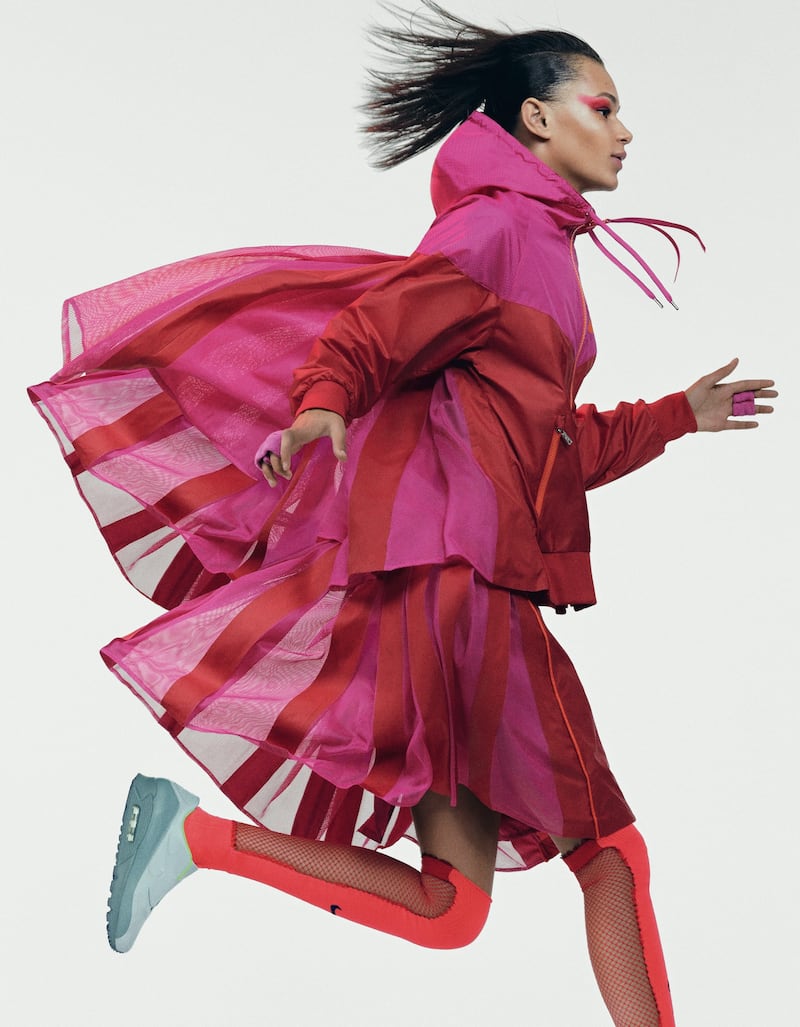
The Business of Fashion
Agenda-setting intelligence, analysis and advice for the global fashion community.

Agenda-setting intelligence, analysis and advice for the global fashion community.

BEAVERTON, United States — Nike is set to launch a womenswear collection developed in collaboration with Sacai, a Japanese label designed by Comme des Garçon alumna Chitose Abe, whose inventive and playful blend of sportswear, material innovation and masculine-feminine elements has attracted a chorus of powerful cheerleaders, including fashion industry titans like Anna Wintour and Karl Lagerfeld.
Abe began work on the eight-piece collection by mining the Nike archives, pulling references from the company's running, tennis and American football lines. She turned to traditional pieces and silhouettes, which she reworked to create functional yet feminine sportswear in bright colours, infused with her playful design signature. Nike's 30-year-old nylon Windrunner jacket, for example, was recast as a skirt with plissé-style panelling, while a hooded sweatshirt was given a peplum with side openings, bringing to the garment a touch of the unexpected, which is typical of Abe's work.
I've always been inspired by original silhouettes and ideas that often come from utility, performance and sportswear.
“I’ve always been inspired by original silhouettes and ideas that often come from utility, performance and sportswear,” Abe told BoF. “Nike is a classic and an original that has a purity about it and a familiarity to the silhouettes that they’ve created over the years, so it’s a perfect fit with my aesthetic and inspiration.”
"Our excitement to work with Chitose was really born from her unique understanding of form and silhouette,” added Kurt Parker, vice president and creative director of Nike Sportswear. “Many of her collections have inspired the design team at Nike, through her elegant and graceful application of materials.”
ADVERTISEMENT
Material innovation was key to the collaboration. The collection uses two different weights of Nike's iconic Tech Fleece, as well as a newly developed mesh lace that trims graphic t-shirts.
"fabric development has always been very important to me," said Abe. "Each season I work with the design team and factories to create new fabric ideas. Nike are also so focused on technology, pushing the boundaries of fabric innovation and performance; that was of great interest to me and I learnt a lot from the process of working together."
The collection also includes versions of Nike’s Air Max and Dunk sneakers, reimagined as slip-ons with elasticised tongues. The Air Max sneakers have a tromp l’oeil design along the outsole, creating the illusion of a wedge, while the Dunk has an actual 20mm wedge.

Nike x Sacai | Source: Courtesy
This collaboration comes in the context of a fast-expanding market for women's activewear — especially in North America — and a growing number of collaborations between fashion labels and sportswear giants like Nike, which has a women's business that generates about $5 billion a year and recently launched collaborations with Brazilian designer Pedro Lourenço and Berlin-based designer Johanna F. Schneider.
“It is still grounded in a great performance product, but the expression of it is much more important. Constantly changing that expression and giving [female consumers] new looks, new experiences, is a key part of what we do,” Nike president Trevor Edwards told BoF earlier in the year. “One of the things that we recognise, certainly in the women’s business, is that there is no performance without style.”
From analysis of the global fashion and beauty industries to career and personal advice, BoF’s founder and CEO, Imran Amed, will be answering your questions on Sunday, February 18, 2024 during London Fashion Week.
The State of Fashion 2024 breaks down the 10 themes that will define the industry in the year ahead.
Imran Amed reviews the most important fashion stories of the year and shares his predictions on what this means for the industry in 2024.
After three days of inspiring talks, guests closed out BoF’s gathering for big thinkers with a black tie gala followed by an intimate performance from Rita Ora — guest starring Billy Porter.